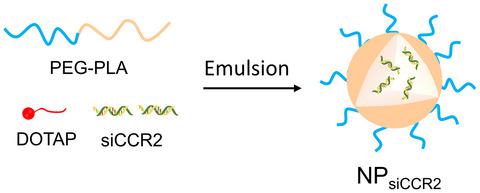Our official English website, www.x-mol.net, welcomes your
feedback! (Note: you will need to create a separate account there.)
CCR2 downregulation attenuates spinal cord injury by suppressing inflammatory monocytes
SYNAPSE ( IF 1.6 ) Pub Date : 2020-10-23 , DOI: 10.1002/syn.22191 Qingpu Zhang 1 , Chunjing Zhu 1 , Xiaojing Li 2 , Yulin Shi 3 , Zhongli Zhang 3
SYNAPSE ( IF 1.6 ) Pub Date : 2020-10-23 , DOI: 10.1002/syn.22191 Qingpu Zhang 1 , Chunjing Zhu 1 , Xiaojing Li 2 , Yulin Shi 3 , Zhongli Zhang 3
Affiliation

|
Specific elimination of blood‐derived macrophages/monocytes following spinal cord injury (SCI) may suppress neurotoxicity without affecting the neuroprotective microglia at the injury sites. We aimed to deplete hematogenous monocytes by downregulating CCR2 through siCCR2‐loaded nanoparticles and investigated its outcome in the recovery of locomotor function of SCI mice. We induced SCI in mice and examined the influx of blood‐derived monocytes into the injury site. We constructed nanoparticles loaded with siRNA targeting CCR2 and examined its efficiency in downregulating the CCR2 expression in cultured RAW264.7 cells and monocytes in vivo. Finally, we assessed the effects of CCR2 downregulation in pro‐inflammatory cytokine production, axon regeneration, and locomotor recovery of the SCI mice. We found that SCI significantly increased the CCL2 expression and number of blood‐derived macrophages/monocytes in the lesion area. Nanoparticles loaded with siCCR2 significantly suppressed the CCR2 expression in hematogenous macrophages/monocytes, reduced the number of hematogenous macrophages/monocytes, and reduced pro‐inflammatory cytokine production at the injury site. Finally, CCR2 downregulation promoted axon regeneration and improved locomotor recovery in SCI mice. Our study suggests that siCCR2 loading nanoparticles are efficient and specific in downregulating hematogenous macrophages/monocytes without affecting the neuroprotective microglia and its efficacy in promoting locomotor recovery in SCI mice warrants further investigation for its clinical application in SCI.
中文翻译:

CCR2下调通过抑制炎性单核细胞减轻脊髓损伤
脊髓损伤 (SCI) 后血源性巨噬细胞/单核细胞的特异性消除可以抑制神经毒性,而不影响损伤部位的神经保护性小胶质细胞。我们旨在通过载有 siCCR2 的纳米颗粒下调 CCR2 来消耗血源性单核细胞,并研究其在 SCI 小鼠运动功能恢复中的结果。我们在小鼠中诱导 SCI,并检查血液来源的单核细胞流入损伤部位。我们构建了载有靶向 CCR2 的 siRNA 的纳米颗粒,并检查了其在体内下调培养的 RAW264.7 细胞和单核细胞中 CCR2 表达的效率。最后,我们评估了 CCR2 下调对 SCI 小鼠促炎细胞因子产生、轴突再生和运动恢复的影响。我们发现 SCI 显着增加了病变区域 CCL2 的表达和血源性巨噬细胞/单核细胞的数量。载有 siCCR2 的纳米颗粒显着抑制了血源性巨噬细胞/单核细胞中 CCR2 的表达,减少了血源性巨噬细胞/单核细胞的数量,并减少了损伤部位促炎细胞因子的产生。最后,CCR2 下调促进轴突再生并改善 SCI 小鼠的运动恢复。我们的研究表明,载有 siCCR2 的纳米颗粒在下调血源性巨噬细胞/单核细胞方面是有效和特异性的,而不影响神经保护性小胶质细胞,其促进 SCI 小鼠运动恢复的功效值得进一步研究其在 SCI 中的临床应用。
更新日期:2020-10-23
中文翻译:

CCR2下调通过抑制炎性单核细胞减轻脊髓损伤
脊髓损伤 (SCI) 后血源性巨噬细胞/单核细胞的特异性消除可以抑制神经毒性,而不影响损伤部位的神经保护性小胶质细胞。我们旨在通过载有 siCCR2 的纳米颗粒下调 CCR2 来消耗血源性单核细胞,并研究其在 SCI 小鼠运动功能恢复中的结果。我们在小鼠中诱导 SCI,并检查血液来源的单核细胞流入损伤部位。我们构建了载有靶向 CCR2 的 siRNA 的纳米颗粒,并检查了其在体内下调培养的 RAW264.7 细胞和单核细胞中 CCR2 表达的效率。最后,我们评估了 CCR2 下调对 SCI 小鼠促炎细胞因子产生、轴突再生和运动恢复的影响。我们发现 SCI 显着增加了病变区域 CCL2 的表达和血源性巨噬细胞/单核细胞的数量。载有 siCCR2 的纳米颗粒显着抑制了血源性巨噬细胞/单核细胞中 CCR2 的表达,减少了血源性巨噬细胞/单核细胞的数量,并减少了损伤部位促炎细胞因子的产生。最后,CCR2 下调促进轴突再生并改善 SCI 小鼠的运动恢复。我们的研究表明,载有 siCCR2 的纳米颗粒在下调血源性巨噬细胞/单核细胞方面是有效和特异性的,而不影响神经保护性小胶质细胞,其促进 SCI 小鼠运动恢复的功效值得进一步研究其在 SCI 中的临床应用。











































 京公网安备 11010802027423号
京公网安备 11010802027423号